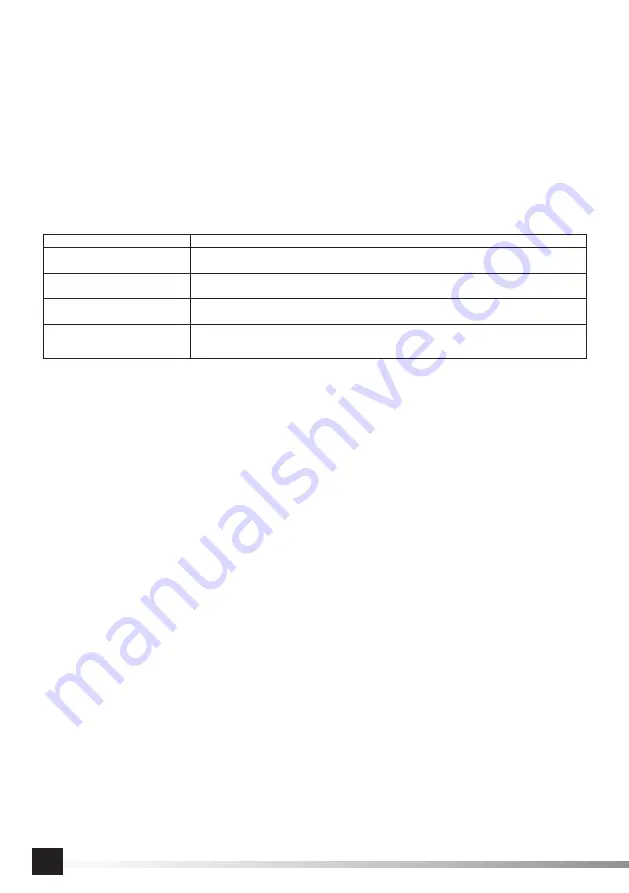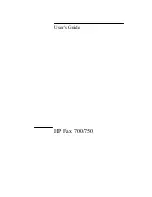
14
O
P
E
R
A
T
I
N
G
M
A
N
U
A
L
GB
Wipe off the excess of oil which comes out of the outlet openings. The remaining oil may damage the sealing of the device.
Other maintenance actions
Before each use of the tool, it is necessary to check whether there are any signs of damage of the tool. Drivers, tool holders and
spindles must be kept clean.
Every six months or after 100 hours of operation, the device must be revised by qualifi ed personnel in a repair shop. If the tool has
been used without the recommended air supply system, then it is necessary to increase the frequency of such controls.
Repairs
Operation of the machine must be interrupted immediately if any defects have been detected. Work with a defective machine may
cause injuries. All repairs or replacements of the elements of the tool must be realised by qualifi ed personnel in an authorised
repair shop.
Damage
Possible solution
The air blown out of the slots at the top of
the tool or around the trigger
Check whether the screws are not loosened. Check the condition of the sealing.
The tool does not start or works slowly
The compressor does not guarantee the appropriate air supply. Connect the device to a more effi cient compressor.
Insuffi cient lubrication. Check the condition of the sealing.
Frequent jamming of the tool.
Incorrect or damaged connecting elements. The dispenser is dirty and does not guarantee appropriate supply of connect-
ing elements.
Insuffi cient power
Make sure the hoses have the correct internal diameter which must correspond at least to the value specifi ed in the table.
Check the adjustment of pressure; it must be set to the maximum acceptable value. Make sure the tool has been properly
cleaned and lubricated. If the problem persists send the tool for repair.
Once the functioning has been concluded, the casing, ventilation slots, switches, additional handle and protections must be
cleansed with a stream of air (at a pressure not exceeding 0.3 MPa), with a brush or a cloth without any chemical substances or
cleaning liquids. Tools and handles must be cleansed with a clean cloth.
Worn tools are recyclable waste – it is prohibited to dispose of them throwing them away along with domestic waste, since the
tools contain substances that are harmful for people and the environment! We ask for your active assistance in economic manage-
ment of natural resources and protection of the natural environment by sending the tools to a worn tools disposal point. In order
to reduce the quantity of waste that is disposed if, it is necessary to recycle them.
Summary of Contents for YT-09212
Page 22: ...22 RUS...
Page 23: ...23 RUS 10 CEN CENELEC...
Page 24: ...24 RUS SAE 10 II IV 13 8 V VII...
Page 25: ...25 RUS VI 0 05 a 0 05 a WD 40 30 SAE 10 SAE 10 WD 40 6 100...
Page 26: ...26 RUS 0 3 MPa...
Page 28: ...28 UA K...
Page 29: ...29 UA 10 CEN CENELEC...
Page 30: ...30 UA SAE 10 II IV 13 8 V VII VI 0 05 a 0 05 a...
Page 31: ...31 UA WD 40 30 SAE 10 SAE 10 WD 40 6 100 0 3 MPa...
Page 84: ...84 GR...
Page 85: ...85 GR 10 O CEN CENELEC E i...
Page 86: ...86 GR SAE 10 II IV 13 8 bar V VII VI 0 05 MPa 0 05 MPa...
Page 87: ...87 GR WD 40 30 SAE 10 SAE 10 WD 40 6 100 0 3 MPa...















































